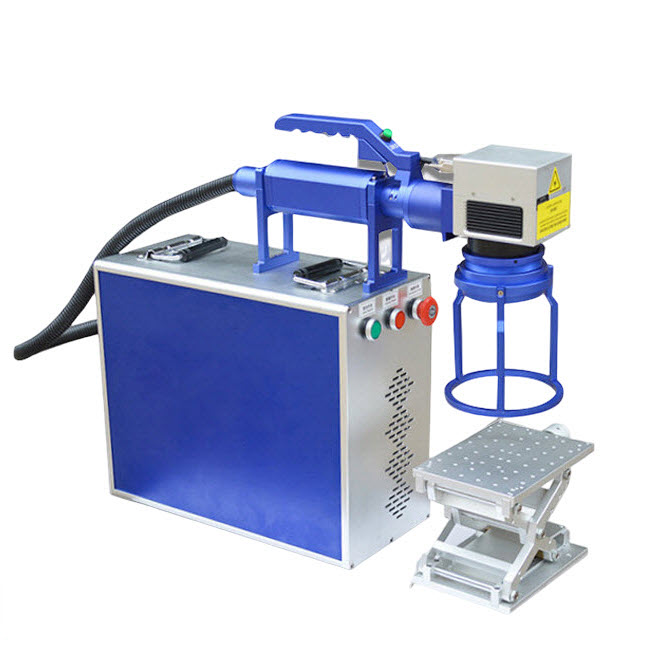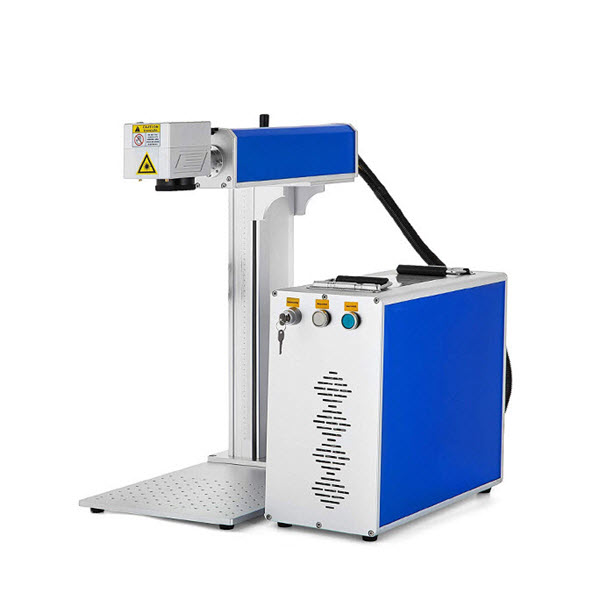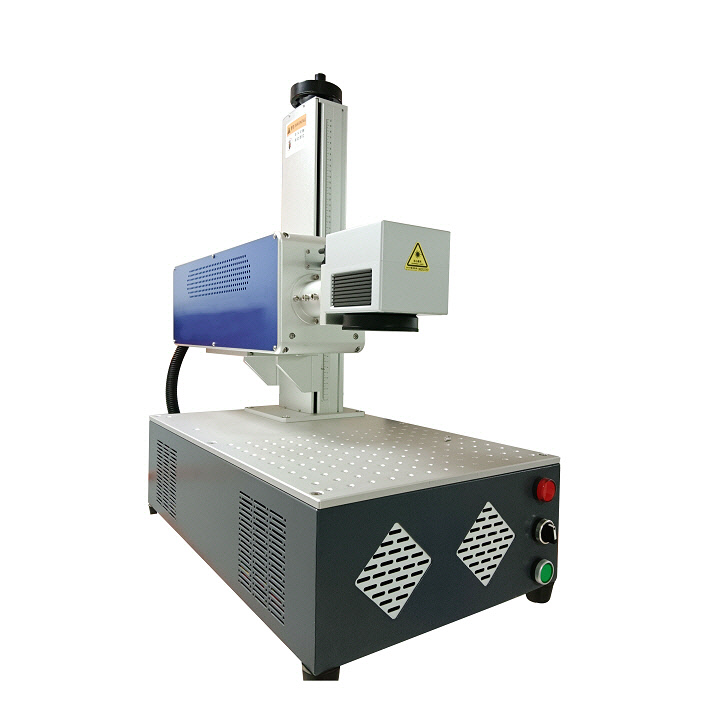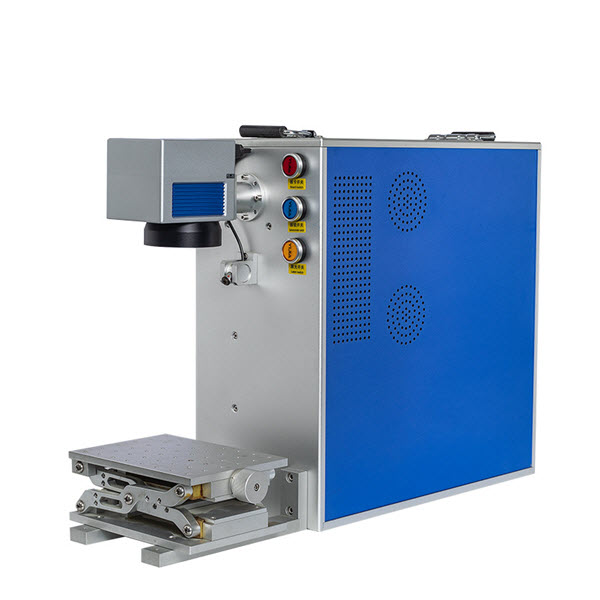
Laser Marking Stainless Steel
2025-10-11Stainless steel, due to its excellent corrosion resistance, high strength, and aesthetically pleasing appearance, is widely used in a wide range of applications, from kitchenware to aerospace. With the advancement of intelligent manufacturing, the demand for clear, permanent, and stylish markings on stainless steel products is growing. Laser marking technology, with its non-contact, high-precision, and environmentally friendly characteristics, has become the preferred solution for stainless steel surface marking.
I. How Does Laser Marking Create Exquisite Marks on Stainless Steel?
Stainless steel laser marking is an advanced processing technology that uses a high-energy-density laser beam to precisely control its interaction with the stainless steel surface, creating a permanent mark. Its core principle is not the addition of pigments or inks, but rather the laser-induced physical or chemical changes in the stainless steel surface, altering its color, gloss, or topography, enabling the clear display of text, QR codes, logos, and other information. Laser marking is not "engraving" or "coating," but rather creates a permanent mark through a physical or chemical reaction between the high-energy laser beam and the stainless steel surface. Depending on the desired marking effect, laser marking is achieved primarily through the following physical mechanisms:
1. Oxidation Discoloration
This is the most common and distinctive stainless steel laser marking method, particularly suitable for austenitic stainless steels such as 304 and 316.
✅ Operating Principle: A low-power, long-pulsed laser (typically a MOPA fiber laser) is used to heat the stainless steel surface in an inert gas (such as nitrogen) or air. Heating induces a controlled oxidation reaction between the metal surface and oxygen, forming an extremely thin, transparent film of chromium oxide (Cr₂O₃).
✅ Color development mechanism: When the thickness of this oxide film approaches the wavelength of visible light (approximately 380–780 nanometers), interference occurs between the incident and reflected light. Oxide films of varying thickness enhance certain wavelengths and suppress others, resulting in different colors. For example: a film thickness of approximately 100 nm results in gold; increasing to 200 nm results in blue or violet; and even thicker film thicknesses result in red, green, and so on.
✅ Marking characteristics: The mark is flat, without indentations, has a smooth feel, and offers rich colors. It is widely used for decoration, anti-counterfeiting, and high-end product identification.
2. Laser Etching/Engraving
Laser etching/engraving is suitable for marking applications requiring deep marking or high wear resistance. It is primarily used in industrial applications where durability, anti-counterfeiting, and traceability are paramount.
✅ Working Principle: Using a high-power, short-pulse laser, the temperature of the stainless steel surface is rapidly raised to its vaporization point (approximately 2700°C or above). The material is instantly vaporized and removed, forming tiny pits or grooves.
✅ Marking Characteristics: The mark is tactile and indented, reaching depths of tens of microns and is extremely wear-resistant. It typically appears off-white or dark gray with high contrast. It is commonly used for serial numbers and barcodes on tools, molds, and mechanical parts.
3. Coating Removal
This method is particularly suitable for marking stainless steel and other metal products that have been painted, electroplated, anodized, or coated.
✅ How it works: The laser energy is absorbed by the surface coating and quickly vaporized, while the underlying stainless steel reflects most of the laser light, leaving it virtually undamaged. By precisely controlling the energy, the coating can be selectively removed, revealing the natural metal color and creating high-contrast images and text.
✅ Marking Features: The mark offers high contrast, with a sharp contrast between the natural metal color and the coating, creating a striking visual effect. The mark resists wear and tear, allowing for a wide range of design possibilities, including complex graphics, gradient effects, and even dynamic code changes. It is commonly used on appliance panels, decorative panels, nameplates, and more.
4. Annealing Marking
Annealing marking is a heat-treatment laser marking process performed at low laser power and slow scanning speeds. It is primarily used for metal materials such as stainless steel and titanium alloys, and is particularly suitable for applications requiring high surface integrity and no physical damage.
✅ Working Principle: During annealing marking, a laser beam heats the metal surface at a low energy density to a certain temperature (typically between 200°C and 500°C), but not to the melting or vaporization point. This controlled heating triggers a selective oxidation reaction on the metal surface, forming a dense, nanometer-thick oxide film (such as chromium oxide (Cr₂O₃) in stainless steel).
✅ Marking Characteristics: This oxide film alters the material's light absorption and reflection properties, resulting in a dark mark (typically black, dark gray, or tan). Because the material itself is not removed or deformed, the marked area remains smooth and flat, without indentations or protrusions. This marking method is primarily used for marking medical devices, food and pharmaceutical equipment, precision instruments, and aerospace components.
These laser marking methods can be used individually or in combination to create beautiful text, QR codes, logos, and even complex patterns.
II. What Types of Lasers Are Used for Stainless Steel Marking?
Stainless steel, due to its high reflectivity, corrosion resistance, and high strength, places high demands on laser marking equipment. Different lasers exhibit varying performance and application scenarios for stainless steel marking due to differences in wavelength, pulse width, power, and thermal properties. The following are several popular laser types used for stainless steel laser marking and their characteristics:
1. MOPA Fiber Laser Marking Machine
With a wavelength of 1064nm, MOPA fiber laser marking machines offer precisely controlled heat input and adjustable pulse width (typically 2–500 ns), making them suitable for a variety of marking types:
✅ Color oxidation marking (full-color effects such as gold, black, blue, and red)
✅ High-contrast black annealing marking
✅ Fine QR codes and tiny text
✅ Shallow and deep engraving
MOPA laser marking machines are commonly used in a variety of applications, such as marking stainless steel products such as medical devices, high-end kitchenware, electronic product casings, and jewelry. It is the only proven technology for color marking on stainless steel. It offers flexible parameter settings and strong adaptability, suitable for a variety of surface finishes (brushing, mirroring, and sandblasting). It also features fast marking speeds and stable results, making it suitable for high-volume production.
2. Standard Fiber Laser Marker (Fixed Pulse Width)
Fiber laser markers with a wavelength of 1064nm offer simple structure, low cost, and high stability, but their pulse width is not adjustable. They are primarily used for the following marking types:
✅ Black/dark gray annealed marking
✅ Serial numbers, barcodes, and simple logos
✅ Medium-depth engraving
Conventional fiber laser markers also have certain limitations. They cannot achieve color marking, have poor adaptability to highly reflective surfaces, lack precise color control, and are prone to burnout and uneven color. They are primarily used for stainless steel industrial parts, tools, hardware, and other applications where color is not a priority.
3. UV Laser Marker
UV laser markers with a wavelength of 355nm are a cold-process marking method that primarily utilizes photochemical action with minimal thermal impact. Suitable marking applications include:
✅ High-precision white or light-colored marking
✅ Ultra-fine patterns and micron-level text
✅ Removal of plating or coatings (such as PVD and anodized layers)
✅ Marking sensitive electronic components
UV laser marking machines offer unique advantages, such as no thermal deformation, suitable for thin-walled or precision parts, sharp, burr-free marking edges, and the ability to achieve high-contrast marking on mirror-finished stainless steel. They are primarily used for marking stainless steel products such as medical implants, sensors, chip housings, and optical devices. However, UV laser marking machines are relatively expensive and unsuitable for deep engraving.
4. Green Laser Marking Machines
Green laser marking machines, with a wavelength of 532nm, have short wavelengths and high metal absorption, making them particularly suitable for marking highly reflective stainless steel. They are primarily suitable for the following marking applications:
✅ High-contrast marking on mirror-finished stainless steel
✅ Fine text and QR codes
✅ Marking with shallow annealing or slight discoloration
A unique advantage of green laser marking machines is their ability to mark on mirror-finished stainless steel. The thermal impact is small and suitable for occasions with high requirements for surface finish. Of course, it also has certain limitations, such as relatively low equipment stability, high maintenance cost, limited power, not suitable for deep engraving, and a narrow application range, mainly used in special demand scenarios.
III. Why Are Laser Marking Machines Widely Used in the Stainless Steel Industry?
Compared to traditional methods such as silk screen printing, chemical etching, mechanical stamping, or inkjet printing, laser marking offers irreplaceable advantages. Consequently, laser marking technology has rapidly gained popularity in the stainless steel processing industry in recent years and has become a mainstream method for industrial marking.
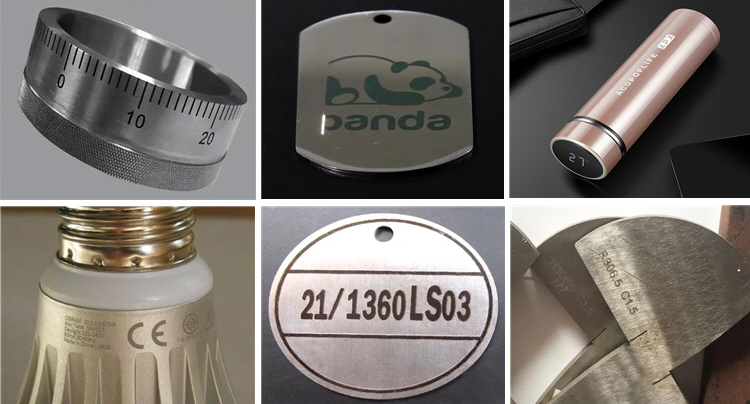
1. Permanent, durable markings, resistant to extreme environments: Stainless steel inherently possesses high strength, corrosion resistance, high temperature resistance, and fade resistance. Laser marking creates a mark that blends seamlessly with the material, offering comparable durability. The mark resists fading and peeling, high temperatures, corrosion resistance, and scratching and polishing. The oxide film formed by annealing can withstand temperatures of hundreds of degrees Celsius, making it resistant to acid, alkali, and solvent cleaning. Unlike ink-based markings, it resists aging and fading due to UV exposure.
2. Non-contact processing, no mechanical damage: Laser marking requires no tools or pressure. Instead, a beam of light is applied to the stainless steel surface, eliminating the stress concentration, deformation, and surface damage associated with traditional stamping and engraving. It is suitable for thin-walled, delicate, or delicate stainless steel parts. It maintains structural integrity without altering the material's mechanical properties. It also eliminates tool wear and reduces maintenance costs.
3. High Precision and Resolution, Supporting Miniaturized Marking: The laser beam can be focused to a micron-level spot, enabling extremely precise marking of images and text. It can mark text as fine as a hairline (e.g., 0.1mm in height) and supports complex QR and Data Matrix codes with high read rates, meeting the micro-marking needs of electronics, medical devices, and other fields.
4. Environmentally Friendly and Safe, Zero Consumables, Zero Pollution: Compared to traditional inkjet or chemical etching, stainless steel laser marking is a truly "green manufacturing" technology. It requires no inks or solvents, effectively avoiding VOC (volatile organic compound) emissions. It also eliminates the need for chemical agents such as acids and alkalis, reducing wastewater treatment costs.
5. Strong Anti-Counterfeiting, Enhanced Brand Protection: Laser marking can generate unique codes, encrypted QR codes, microtext, and other difficult-to-replicate markings, effectively preventing counterfeiting and counterfeiting, supporting full lifecycle traceability and improving quality management. It is particularly suitable for marking high-value or safety-sensitive stainless steel products.
6. Wide range of materials and flexibility: Laser marking is compatible with a variety of stainless steel types (304, 316, 430, 2205, etc.) and surface finishes (brushed, mirrored, sandblasted, electroplated). Simply adjust the parameters to achieve the desired marking effect.
Laser marking is particularly popular in the stainless steel sector because it perfectly matches the material's high-end properties, such as durability, cleanliness, aesthetics, and reliability. It is not only a means of identification but also a crucial technical support for brand upgrading and green production.
IV. What Types of Stainless Steel Can be Laser Marked?
Laser marking technology has a wide range of material compatibility, and most types of stainless steel can be laser-marked. Whether it's common industrial steel or high-end specialty alloys, by selecting the appropriate laser type and process parameters, you can achieve clear, permanent, and beautiful markings. The following are common stainless steel types and their suitability for laser marking:
1. Austenitic Stainless Steel
Typical grades such as 304, 304L, 316, 316L, 321, and 904L can all be marked with laser marking machines. Austenitic stainless steel has a high nickel content (8–12%), strong corrosion resistance, and excellent plasticity, making it the most widely used material. Laser marking machines can perform color oxidation marking on these stainless steels, enabling the creation of a variety of colors, including gold, black, blue, and red. Laser marking is widely used to mark stainless steel surfaces such as medical devices, food equipment, kitchenware, and electronic products. Typical applications include UDI codes on surgical instruments, logos on faucets, and serial numbers on mobile phone frames.
2. Martensitic Stainless Steel
Typical grades include 410, 420, and 440A/B/C. These materials can be heat-treated to strengthen their hardness and wear resistance. Laser marking enables deep engraving and high-contrast marking. They are commonly used for wear-resistant marking on tools, knives, bearings, and other applications. Typical applications include brand logos on scalpels, razor blade numbers, and mold serial numbers.
3. Ferritic Stainless Steel
Typical grades include 430, 409, and 434. These grades have a high chromium content (12–30%), are nickel-free, offer low cost, and offer moderate corrosion resistance. These materials are suitable for laser marking, exhibit a weak oxidation reaction, and are difficult to color-mark. They are primarily used for black and white or dark gray markings, such as nameplates and appliance panels. Typical applications include model labels on oven housings and automotive exhaust pipe markings.
4. Duplex Stainless Steel
Typical grades include 2205 (S31803/S32205) and 2507. These grades have a mixed austenitic and ferritic structure, resulting in high strength and resistance to stress corrosion cracking. They are primarily used in harsh environments. Laser marking is possible, but parameters must be optimized to avoid localized overheating and structural changes. Low heat input annealing using a MOPA fiber laser is recommended. Marking results are typically dark gray or black and are used in the petroleum, chemical, and marine engineering industries. Typical applications include offshore platform pipeline numbering and chemical valve information marking.
5. Precipitation Hardening Stainless Steel (PH)
Typical grades include 17-4PH (SUS630) and 15-5PH. These materials can achieve extremely high strength through heat treatment, combining excellent corrosion resistance with mechanical properties. They are widely used in aerospace and precision parts. Marking often involves shallow engraving or annealing, but heat input must be controlled to prevent degradation of the material's mechanical properties. Representative applications include aircraft fastener numbering and satellite component identification.
Austenitic stainless steels (such as 304 and 316) are optimal for laser marking, particularly for color, high-precision, and medical-grade applications. Other grades, such as martensitic, ferritic, and duplex steels, can also achieve high-quality marking through appropriate selection and parameter optimization. Companies should select appropriate laser equipment and conduct process validation based on the specific material, application, and marking requirements to ensure the final marking meets both functional and aesthetic standards.
V. What Are the Key Factors Affecting Stainless Steel Laser Marking?
1. Laser Type: The laser is the core device that determines the marking effect, and different types and configurations directly affect the quality of the mark. MOPA fiber lasers support pulse width modulation, enabling a variety of effects such as color, annealing, and engraving. Standard fiber lasers are suitable only for black and white marking and cannot achieve color.
UV/green lasers are suitable for high-precision, low-heat-impact applications (such as mirror-finished stainless steel).
2. Process Parameter Settings: Fine-tuning the laser marking machine parameters is key to achieving ideal results and requires dynamic adjustment based on the material and requirements.
Laser Power: Higher power results in darker or darker marks; excessive power can cause melting and spattering.
Scanning Speed: Slower scanning speeds result in greater heat input, resulting in darker marks or severe oxidation; faster scanning speeds result in lighter marks.
Frequency (Pulse Frequency): Higher frequency results in higher dot density and smoother marking lines; lower frequency results in dot-like marks. Pulse Width: Specific to MOPA models, short pulse widths are suitable for fine marking, while long pulse widths are beneficial for color oxidation.
Scan Count: Multiple scans can enhance color or depth, but excessive scans may cause overheating and deformation.
3. Stainless Steel Material Characteristics: The material's composition, structure, and surface condition directly influence the interaction between the laser and the material.
Alloy Composition: Stainless steels with high nickel and chromium content (such as 304 and 316) are more likely to form stable oxide films and are suitable for color marking; low-carbon steel or ferritic steel (such as 430) has weaker coloring properties.
Grade Variation: The same grade of material from different manufacturers and batches may have trace element variations, affecting marking consistency.
Metallographic Structure: Austenitic, martensitic, and duplex steels respond differently to heat, requiring individual parameter adjustments.
4. Stainless Steel Surface Condition: The surface roughness and treatment of stainless steel significantly influence laser absorption and visual quality.
Brushed Surface: A distinct grain direction results in clear markings and a strong decorative effect. Mirror surfaces: Highly reflective, with low laser absorption, prone to uneven marking. Green or UV lasers are recommended.
Sandblasted/matte surfaces: Diffusely reflective, resulting in a darker background and high-contrast marking.
Electroplated/PVD coatings: Marking can be done by "stripping" to expose the underlying metal.
Oil stains or protective films: Pre-cleaning is essential to remove any oil stains or protective films, otherwise marking failure or color distortion may occur.
5. Operator Experience and Proofing Verification: Experienced technicians can quickly identify issues and optimize parameters.
Proofing testing is essential: Before mass production, small sample tests should be conducted to confirm that color, depth, and contrast meet standards. A "marking process database" should be established to record the optimal parameter combinations for different materials to improve stainless steel marking efficiency.
VI. What Are the Common Challenges of Stainless Steel Laser Marking?
Although laser marking technology has been widely used on stainless steel, it still faces many challenges in practical application. Only by fully understanding these challenges and selecting the appropriate equipment can stable, high-quality marking be achieved. The following are common challenges encountered during stainless steel laser marking, along with specific equipment selection recommendations.
1. Color marking is unstable or impossible: In this case, it is recommended to use a MOPA laser, control the ambient temperature and humidity, and perform proofing before full production.
2. Highly reflective stainless steel has a low surface absorption rate, making it difficult to mark: In this case, it is recommended to use a green or UV laser marking machine, or perform a sandblasting pre-treatment.
3. Excessive heat-affected zone causes material deformation or uneven discoloration: In this case, it is recommended to reduce the power, increase the speed, and reduce the number of scans.
4. Poor consistency in mass production: In this case, it is recommended to use high-stability equipment, automated positioning, and regular equipment calibration.
5. Special alloys are difficult to color (such as 430 and duplex steel): In this case, it is recommended to use deep engraving or annealing instead of color, accepting a monochrome effect.
VII. How to Choose the Right Laser Marking Machine?
Selecting the right stainless steel laser marking machine requires precise matching based on the desired marking effect and material properties.
For most stainless steel materials, especially austenitic stainless steels like 304 and 316, MOPA fiber laser marking machines are recommended. Their adjustable pulse width allows for precise control of heat input, enabling a variety of color oxidation markings, such as gold, black, and blue. They are also capable of high-contrast annealed markings and deep engraving. For simple black-and-white serial numbers or QR codes, standard fiber lasers can also meet these requirements at a lower cost. For mirrored or highly reflective stainless steel surfaces, green or UV lasers can be considered to improve absorption and ensure clear markings.
In addition, the appropriate power (typically 20W–50W) and configuration should be selected based on the production scale. For large-scale production, emphasis should be placed on equipment stability, automation integration capabilities (such as on-the-fly marking and automatic loading and unloading), and the use of high-quality galvanometers and field lenses to ensure accuracy.
When choosing a brand, prioritize companies with mature technology and excellent after-sales service. Be sure to provide actual samples for testing to verify color uniformity, QR code readability, and long-term durability. This ensures the selected equipment is stable and reliable in actual use and meets product quality and traceability requirements.
VIII. NITRATEK Fiber Laser Marker Successfully Marks Logo on Stainless Steel Products
This video showcases a NITRATEK customer's successful use of a fiber laser marking machine to mark their brand logo on stainless steel products. The customer chose a NITRATEK desktop fiber laser marking machine, which features fast scanning speeds and produces black logos with sharp lines, high contrast, and smooth edges. If you would like to learn more about laser marking technology or products, please feel free to contact us.
Laser marking technology is redefining the standard for stainless steel marking. It not only enhances product functionality and aesthetics, but also provides strong technical support for digital traceability, brand anti-counterfeiting, and green manufacturing. With the continuous advancement of laser technology, stainless steel laser marking will continue to develop towards higher precision, richer colors, and more intelligent control.

